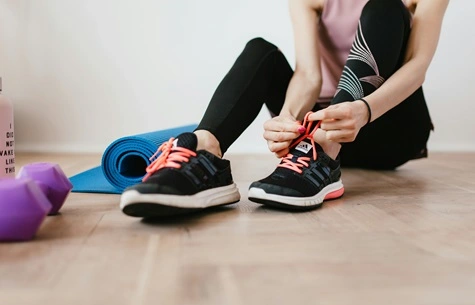Running posture isn’t just about how you move; it significantly influences your overall physical well-being and mental clarity. Understanding and maintaining correct running posture can transform your running experience and its effects on your body.
Running with the right posture is crucial for maximizing benefits and minimizing injury risks. Proper posture ensures efficient movement, helps distribute impact evenly throughout your body, and reduces strain on joints.
Correct running posture involves several key elements:
Keep your body upright with a slight lean forward from the ankles, not the waist.
Relaxed and pulled back, not hunched forward.
Bent at about 90 degrees, swinging naturally with your stride.
Engaged to stabilize your body and support your spine.
Land mid-foot or on the balls of your feet, not heel-first.
Adopting and maintaining proper running posture offers a range of benefits:
a. Reduces the risk of overuse injuries such as shin splints, IT band syndrome, and plantar fasciitis.
b. Improves oxygen intake and energy efficiency.
c. Enhances muscle strength, particularly in the core and lower body.
a. Boosts mood through the release of endorphins.
b. Increases mental focus and clarity.
c. Reduces stress levels and promotes relaxation.
Beyond its immediate benefits, correct posture contributes to long-term physical health:
a. Strengthens core muscles, improving overall body stability and balance.
b. Promotes better spinal alignment, reducing the likelihood of chronic back pain.
c. Enhances body tone and posture, creating a more confident and upright appearance.
Despite its importance, many runners unknowingly adopt incorrect postures due to various factors:
1. Fatigue and muscle weakness.
2. Lack of awareness or improper training techniques.
3. Inappropriate footwear or running surface.
1. Increases the risk of injuries such as knee pain, Achilles tendinitis, and lower back strain.
2. Leads to inefficient running mechanics and decreased performance.
3. Contributes to muscular imbalances and joint wear over time.
Correcting improper running posture requires awareness and effort:
Pay attention to your body alignment during runs and adjust as needed.
Incorporate exercises that target core stability, hip strength, and posture correction.
Consider consulting a running coach or physical therapist for a gait analysis and personalized advice.
Make changes gradually to allow your body to adapt and avoid overexertion.
Mastering correct running posture is not just about improving your performance; it's about safeguarding your long-term health and well-being. By adopting proper alignment, engaging core muscles, and maintaining relaxed but focused form, you not only enhance your running experience but also protect yourself from unnecessary injuries and strain. Remember, small adjustments in posture can yield significant benefits over time, contributing to a stronger, more resilient physique and a more enjoyable running journey.
Treadmill fitness apps can be a useful tool for runners looking to improve their form and track their progress. They often provide insights into your running mechanics and can help you identify areas for improvement. For those interested in more advanced tracking, treadmill tracker apps offer detailed analytics and can sync with various devices for comprehensive feedback on your running performance.
Investing in understanding and improving your running posture today can lead to lasting benefits tomorrow. Whether you're a seasoned marathoner or a casual jogger, prioritizing correct posture will help you run stronger, longer, and with greater joy. With the help of technology, such as smart home gym comparison tools, you can find the perfect treadmill for your home gym, complete with features like treadmill with virtual courses for an immersive and engaging workout experience.


